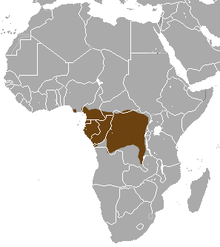The long-nosed mongoose (Xenogale naso) is a mongoose native to Central African wetlands and rainforests. It has been listed as Least Concern on the IUCN Red List since 1996.[3] Although formerly classified in Herpestes, more recent studies indicate that it belongs in the monotypic taxon Xenogale.[4][5]
| Long-nosed mongoose | |
|---|---|

| |
| Scientific classification | |
| Domain: | Eukaryota |
| Kingdom: | Animalia |
| Phylum: | Chordata |
| Class: | Mammalia |
| Order: | Carnivora |
| Suborder: | Feliformia |
| Family: | Herpestidae |
| Genus: | Xenogale Allen, 1919 |
| Species: | |
| Binomial name | |
| Xenogale naso[1][2] (de Winton, 1901)
| |

| |
| Long-nosed mongoose range | |
Distribution and habitat
editThe long-nosed mongoose is native to wetlands and rainforests from the Niger Delta in Nigeria, Cameroon to the Central African Republic, Equatorial Guinea, Gabon, Republic of the Congo and Democratic Republic of the Congo. It has been recorded from sea level up to an elevation of 640 m (2,100 ft).[3] It is one of the most water dependent species.[6]
Behaviour and ecology
editThe long-nose mongoose is usually solitary and lives in a home range of 41–46 ha (100–110 acres). It moves up to 4,600 m (15,100 ft) daily in this area foraging for food. It chooses different locations as night-time resting places.[7]
Threats
editThe long-nosed mongoose's habitat is fragmented because of logging, mining, and slash-and-burn agricultural practices.[3] In Gabon, it is hunted for sale in bushmeat markets.[8]
References
edit- ^ de Winton, W. E. (1901). "Description of a New Mongoose from West Africa". Bulletin of the Liverpool Museums Under the City Council. 3 (2): 35–37.
- ^ Wozencraft, W. C. (2005). "Species Herpestes naso". In Wilson, D. E.; Reeder, D. M. (eds.). Mammal Species of the World: A Taxonomic and Geographic Reference (3rd ed.). Johns Hopkins University Press. p. 569. ISBN 978-0-8018-8221-0. OCLC 62265494.
- ^ a b c d Ray, J.; Bahaa-el-din, L.; Angelici, F. M. & Do Linh San, E. (2015). "Herpestes naso". IUCN Red List of Threatened Species. 2015: e.T41615A45207915.
- ^ Zhou, Y.; Wang, S.-R.; Ma, J.-Z. (2017). "Comprehensive species set revealing the phylogeny and biogeography of Feliformia (Mammalia, Carnivora) based on mitochondrial DNA". PLOS ONE. 12 (3): e0174902. Bibcode:2017PLoSO..1274902Z. doi:10.1371/journal.pone.0174902. PMC 5373635. PMID 28358848.
- ^ "Xenogale naso (de Winton, 1901)". ASM Mammal Diversity Database. American Society of Mammalogists. Retrieved 2021-07-08.
- ^ Veron, G.; Patterson, B.; Reeves, R. (2008). "Global Diversity of Mammals (Mammalia) in Freshwater". In Balian, E. V.; Lévêque, C.; Segers, H.; Martens K. (eds.). Developments in Hydrobiology. Vol. 198. Freshwater Animal Diversity Assessment. Dordrecht: Springer. pp. 607–617. doi:10.1007/s10750-007-9122-1. S2CID 21156997.
{{cite book}}:|journal=ignored (help) - ^ Ray, J. C. (1997). "Comparative ecology of two African forest mongooses, Herpestes naso and Atilax paludinosus". African Journal of Ecology. 35 (3): 237–253. Bibcode:1997AfJEc..35..237R. doi:10.1111/j.1365-2028.1997.086-89086.x.
- ^ Bahaa-el-din, L.; Henschel, P.; Aba’a, R.; Abernethy, K.; Bohm, T.; Bout, N.; Coad, L.; Head, J.; Inoue, E.; Lahm, S.; Lee, M. E.; Maisels, F.; Rabanal, L.; Starkey, M.; Taylor, G.; Vanthomme, A.; Nakashima, Y.; Hunter, L. (2013). "Notes on the distribution and status of small carnivores in Gabon" (PDF). Small Carnivore Conservation (48): 19–29.
